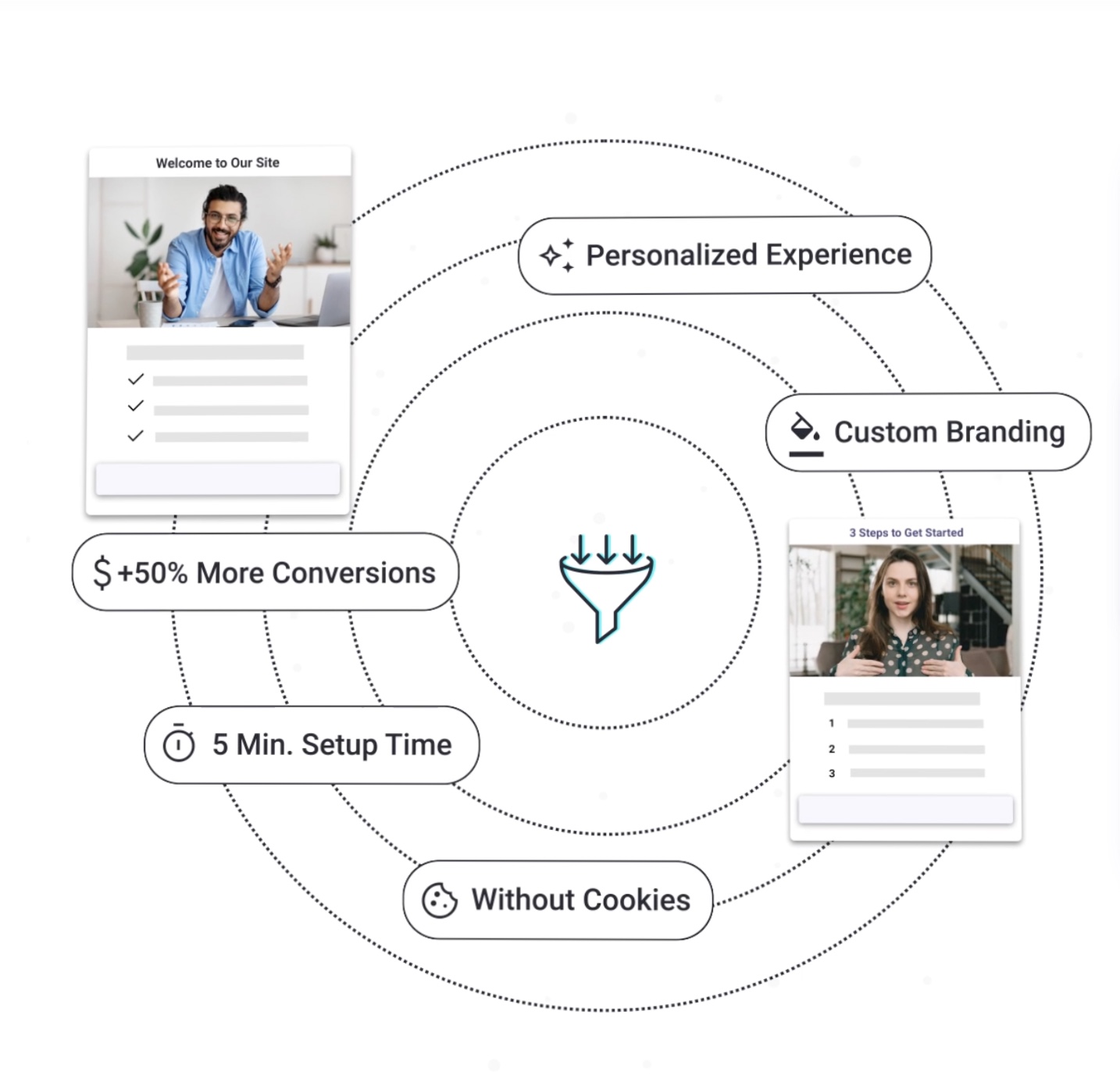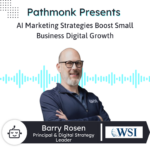
Introduction
Join us in today’s episode of Pathmonk Presents as we host Kyle Lacy, Chief Marketing Officer of Jellyfish, an innovative platform dedicated to engineering management.
In this insightful episode, Kyle explores valuable strategies for marketing teams to align their efforts with engineering insights and broader business objectives.
Learn how Jellyfish enables engineers and leaders to demonstrate the tangible impact of their product development efforts, thereby facilitating smooth collaboration between technical and non-technical stakeholders.
More Sales From Your Website With AI
Personalized interactions based on your users' behaviour to get +50% more conversions.

Ernesto Quezada: Pathmonk is the intelligent tool for website lead generation. With increasing online competition, over 98% of website visitors don’t convert. The ability to successfully show your value proposition and support visitors in their buying journey separates you from the competition. Online Pathmonk qualifies and converts leads on your website by figuring out where they are in the buying journey and influencing them in key decision moments. With relevant micro experiences like case studies, intro videos, and much more, stay relevant to your visitors and increase conversions by 50%. Add Pathmonk to your website in seconds. Let the AI do all the work and get access to 50% more qualified leads while you keep doing marketing and sales as usual. Check us on pathmonk.com. Welcome to today’s episode. Let’s talk about today’s guest. We have Kyle Lacy from Jellyfish, CMO with them. How are you doing today, Kyle?
Kyle Lacy: I am doing brilliant. Thank you for having me.
Ernesto: It’s great to have you on today’s episode, and I’m sure our listeners are tuning in and wondering what Jellyfish is all about. So, in your own words, Kyle, tell us a little bit more.
Kyle: So we call ourselves an engineering management platform, and it enables engineers and engineering leaders to align their work with business objectives. So how does an R&D team show that the products they are building deliver business impact?
Ernesto: Okay, perfect. All right. And so that way, our listeners who are tuned in could get a good understanding of Jellyfish. What would you say is the key problem that you guys like to solve at Jellyfish?
Kyle: I mean, I’ll simplify it pretty drastically. Coming from a CMO’s position who sits in board meetings a lot of times, engineering teams are a black box. It’s easy for marketing to get up and give data. It’s easy for the sales leader to give up and give data on quota attainment as an example. It’s much harder for an R&D leader to stand up in a board meeting or a leadership team meeting and give visibility into what the team is doing and how that affects the business. Jellyfish opens up that black box to give visibility into the engineering, everything they do, how they operate.
Ernesto: Okay, great. Great to hear that. And, I mean, I don’t want to assume, but then are there verticals or an ideal ICP for you guys at Jellyfish?
Kyle: I mean, the ideal persona is an engineering manager, engineering leader, vice president of engineering, CTO, DevOps. There’s a lot of different persona types. We also have a product that automates software capitalization for finance teams. From a vertical perspective, it’s any company that has a large engineering team. Honestly, that could be anyone from a consumer brand company to a software company.
Ernesto: Okay, perfect. All right. And I mean, so how would these engineers or finance teams usually find out about Jellyfish? Is there a top client acquisition channel for you guys?
Kyle: We work pretty heavily on both inbound and outbound. We also do quite a bit of sponsorships of communities like Engineering Leadership Council (ELC). I’d say the top way that we get in front of people is events like in-person dinners, conferences, and then there’s the community element online, which is more on the social side.
Ernesto: Okay. All right, great. And so that way our listeners who are tuned in can go ahead and visit you guys. You could always check them out at Jellyfish Co. What role does the website play then for client acquisition paths?
Kyle: I mean, the website’s the second most important product that we have as a company. So if that says anything for me as a marketing leader, it is the marketing team’s most important product. How you activate it, how you test it, the messaging, the positioning, the design, the performance, we keep an eye on it just like our engineering teams keep an eye on our product, on our flagship product.
Ernesto: Yep, I would agree with that. And on that note, are there any tools or methods that you would recommend to our listeners for website lead generation?
Kyle: I mean, invest in search. We use a company called Demandwell to do that. It’s how do you scale SEO? So content production, that’s number one. Second one is Hotjar for heat mapping to understand where people are going and to make sure that you’re doing quality A/B tests. We use a product called Intellimize that helps with the personalization of content depending on the IP address. So if you’re an enterprise customer coming to our website, the content’s going to change based on if you’re a prospect, as an example. We use that to test. For me, it’s what content is being produced and how does it drive thought leadership and revenue? Do you understand what’s actually happening on the site in terms of heat mapping? And then how do you personalize content in an appropriate way for the people that are visiting? That’s kind of the three buckets. And then there’s performance, of course, but that’s a bit separate.
Ernesto: Okay, great. Some great advice there for our listeners. Let’s switch gears a little bit, Kyle, and let’s talk about you as a leader. If you being the CMO there for Jellyfish, what are some key tasks you like to focus on in your day-to-day work?
Kyle: My main concern is serving my team. I have two teams: the executive team and the marketing team. The question I ask myself daily is, what are you doing today to help serve both those teams in a meaningful way? You’re either moving a project forward that needs to be completed for a business objective or you’re removing barriers and roadblocks for your team to get their job done. I don’t like to say manage or lead; it’s more serve because that’s what you’re doing. You’re serving a team of individuals to make sure they’re doing their best work. So for me, it’s how do I make sure I’m doing those two things for those two teams?
Ernesto: That’s great to hear. Great leadership there. In your in-between times, is there a preferred channel to stay up with all the marketing strategies and trends out there?
Kyle: So there’s two Substacks that I read: Lenny’s Newsletter, which is more state-of-the-art what’s happening in the market, and Ultra Successful by Dr. Julie Gurner, which is more leadership-oriented. I’m also part of a community called Pavilion, which has thousands of practitioners and has been a source of knowledge for me since 2017. The third way is LinkedIn. I spend a lot of time networking, building community on that site, and it does surface things for me for sure.
Ernesto: All right, awesome to hear that. Thank you so much for sharing that with us. Let’s jump into our next section, Kyle, which is our rapid-fire question round. Are you ready for them?
Kyle: Love rapid fire. Let’s do that.
Ernesto: First off, what is the last book that you read?
Kyle: The Thirty Years’ War. About the Thirty Years’ War in Europe. I know it seems I read that question, and I was like, oh, this is going to be lame because I don’t really read business and marketing books. It’s more history. Before that was The Three-Body Problem, which I highly recommend. So I usually read sci-fi or history.
Ernesto: Well, that’s important, right? Kind of like distracting your mind. All day you’re at work. I like asking this question because some people answer business, some people answer fiction, nonfiction, and it’s interesting. If you go with the fiction, it’s kind of like in your own world, you’re relaxing.
Kyle: Well, if you’re doing business and marketing 12 hours a day, the time you spend with your family and the time you spend reading is not going to be spent reading about marketing.
Ernesto: Definitely, definitely would agree with you. I mean, as long as you’re there at work and you’re doing that, then that’s all right. Other than that, there’s a time and place for that. Awesome. Next up, what is one single thing that Jellyfish is focused on at the moment the most?
Kyle: It’s our core business statement, and it’s always our mission statement. How do you make engineering leaders business leaders? Every company is a software company now.
Ernesto: I would totally agree with that. Next, if there’s one repetitive task that you could automate, what would that be?
Kyle: If I could automate my inbox and calendar. I use Calendly, which is a great product. If I could automate responding to things and managing tasks in a meaningful way, that would be very helpful.
Ernesto: I think, for everybody, right?
Kyle: Yeah, that would be awesome. For sure. We’re going to get there, believe me. But I haven’t seen it yet.
Ernesto: I think we will get there. It’s just that personalization, learning from the user. At one moment, I’m sure we’ll get there.
Kyle: There’s a company called Day AI that I think is moving pretty quickly towards it. I need to dig back into where they’re at on their products, but that was always an interesting one to me.
Ernesto: All right, great. Next, if there were no boundaries in technology, what would be the one thing that you want to have fixed for your role as a marketer today?
Kyle: If there were no boundaries, it would still have to do with AI and data collection. Being able to manage and organize data from all the multiple sources in a meaningful way, displayed with intelligence that gives you choices on what to do in the future. Strategic choices. As a marketer, instead of looking at a bunch of Salesforce dashboards, I want a go-to-market dashboard that gives you next steps and flags things that might be happening in the pipeline with quota attainment, messaging, and positioning. Think about a chief of staff for a CMO. A combination of product marketing, chief of staff, and RevOps.
Ernesto: All right, awesome. And like you mentioned, not to reach out to you. No worries. Maybe a couple, but not too many.
Kyle: Right.
Ernesto: Lastly, Kyle, I’d love to ask this question because you have a lot of experience. What is that one piece of advice that you would give yourself if you were to restart your journey as a marketer coming out of Anderson University?
Kyle: Slow down. I think slowing down is what I would say. I’d say don’t put too much of your self-worth in your career, but I don’t think I would ever change that. Slowing down and being more strategic would have benefited me in some parts of my career. Hindsight is 20/20, but definitely slow down, take a breath, be more strategic. Don’t just rush to get things done all the time.
Ernesto: Definitely important advice there. Thank you so much for sharing that with us, Kyle. I’m sure listeners are taking that advice as well. We are coming to the end of the show today. Before we do, I want to give you the last word. If someone forgets everything about the interview today, what is the one thing they should remember about Jellyfish?
Kyle: If you’re having a hard time understanding how your engineering team functions, we can help with that. And the second thing would be to slow down, people. It’ll be all right.
Ernesto: You guys heard it from Kyle. Check them out at Jellyfish Co. Anticipate, build, and deliver with your engineering team. Kyle, thank you so much for being on with us today. To our listeners, thank you so much for tuning in. I’m looking forward to our next episode at Pathmonk Presents. Thanks a lot, Kyle.
Kyle: Thanks for having me.










